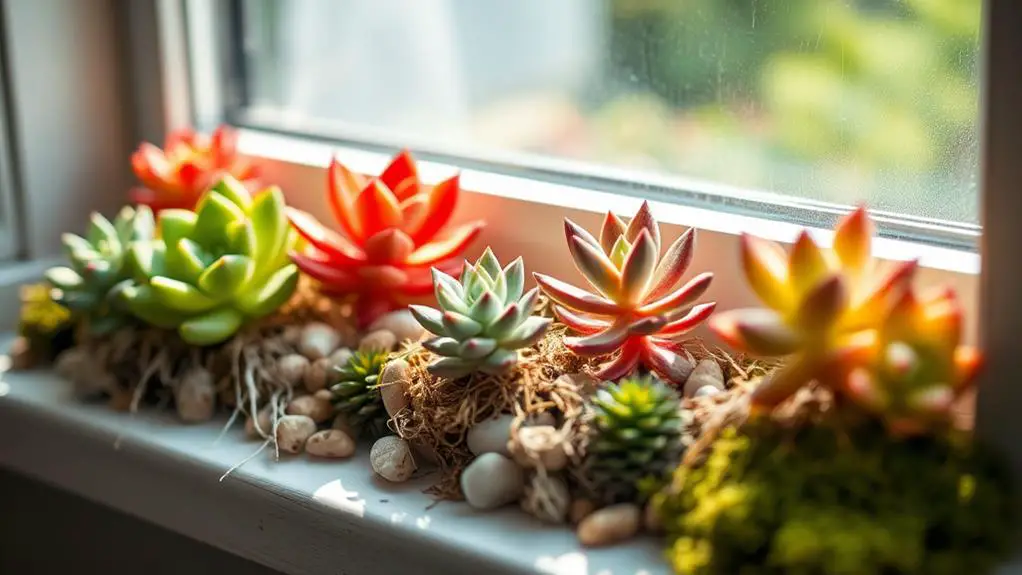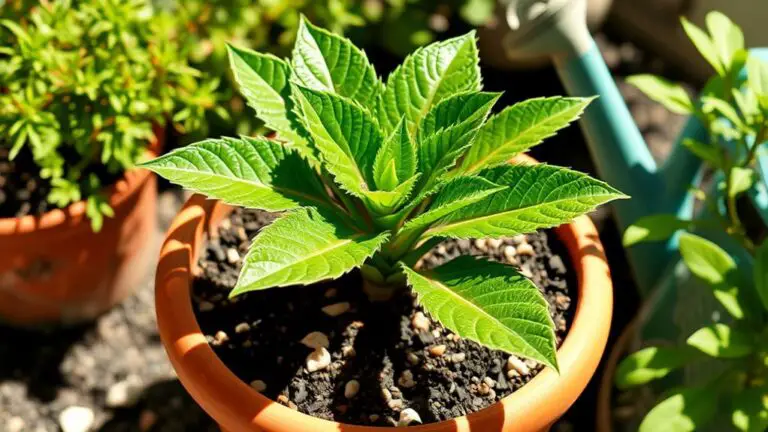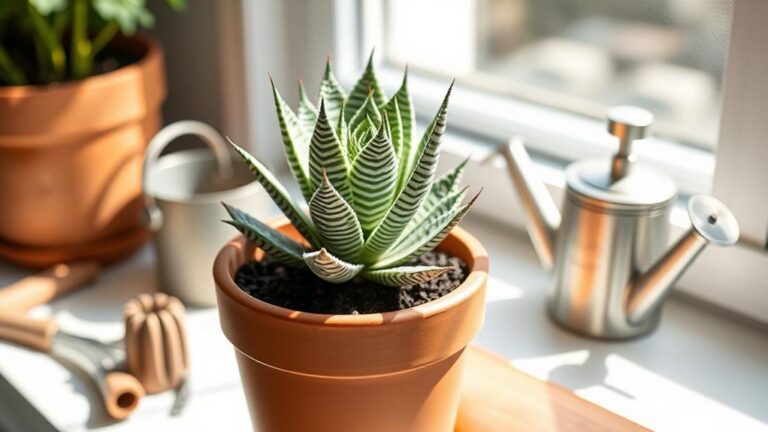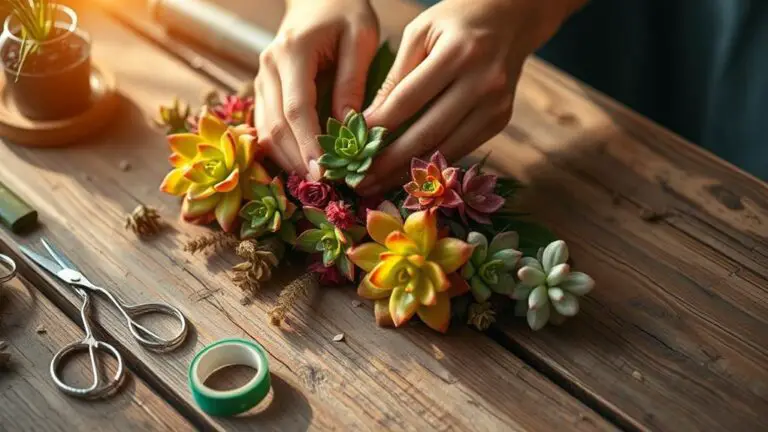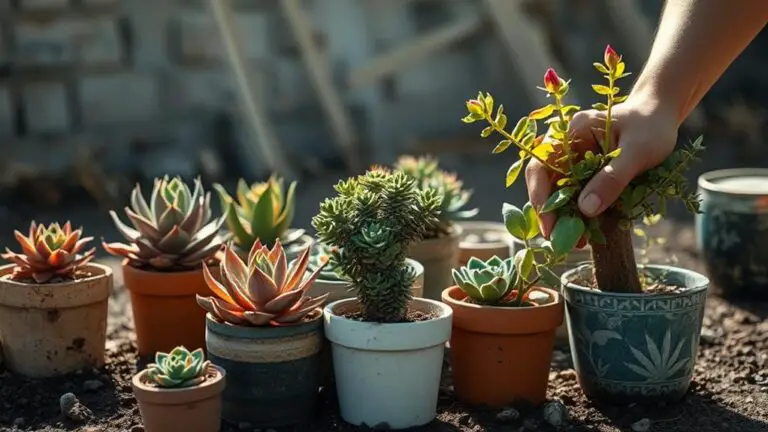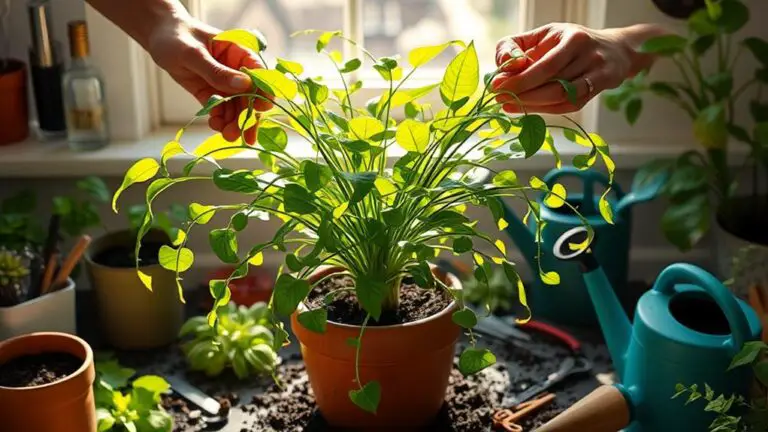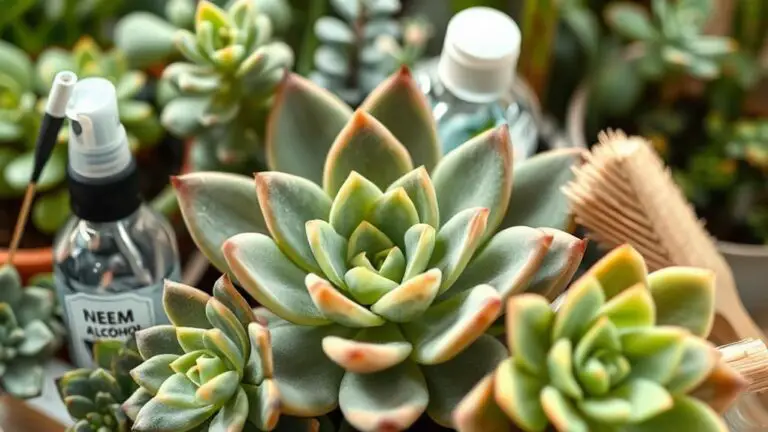How Long Can Succulents Survive Without Soil?
You might wonder how long succulents can survive without soil, and the answer isn't as straightforward as it seems. While they can last up to two weeks, it's not just a matter of time; it's about the care they receive during that period. Proper hydration is vital, but too much water can be detrimental. You need to strike a balance and keep an eye on them for any signs of stress. Curious about how to maintain their health and what alternatives you can explore for potting mediums? There's more to uncover about ensuring these resilient plants thrive.
The Short Answer
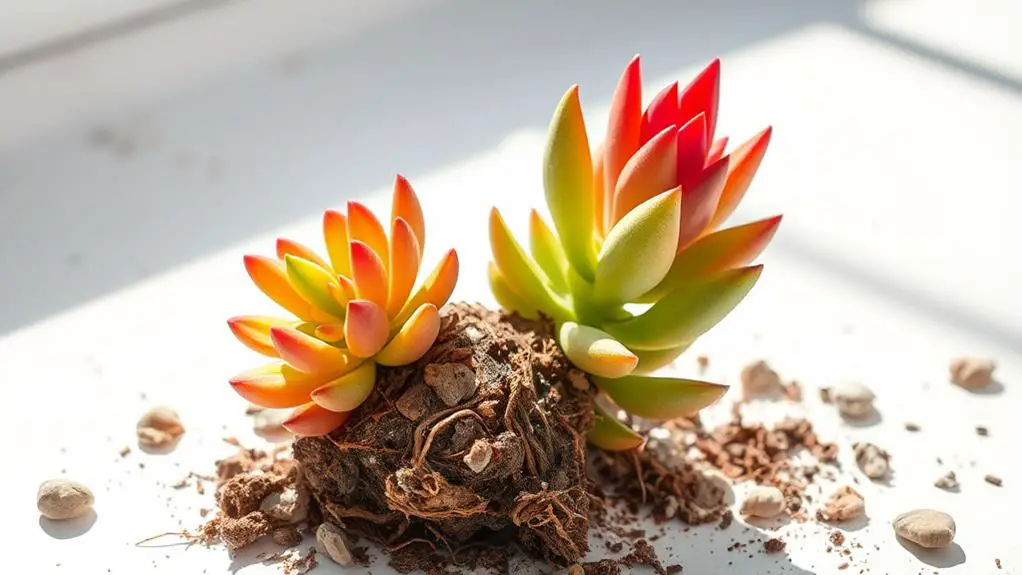
Succulents can survive without soil for up to two weeks if you give them the proper care. During this time, these hardy plants need to be watered sparingly, ensuring their roots stay hydrated without being submerged. Temporary arrangements, like wreaths or boutonnieres, often expose their roots, making it essential to monitor them closely.
While succulents can endure short periods without soil, regular monitoring is important to keep them healthy. Check for signs of wilting or dryness, and adjust their care as needed. You'll want to keep an eye on their health, making sure they don't start declining.
Even though succulents can survive without soil, they ultimately need a potting medium to thrive in the long run. Soil helps protect their roots and provides the necessary nutrients. Without it, succulents will begin to wilt and lose their energy.
Keeping Succulents Alive

To keep your succulents alive without soil, focus on meeting their hydration needs and closely monitoring their condition. Succulents can survive up to two weeks without soil, but they need extra care to stay healthy.
Start by ensuring they get enough water. While too much water can harm succulents, misting them lightly or using a syringe to target their roots can provide the hydration they need without overdoing it.
Keep a close eye on your plants. Regular monitoring helps you spot any signs of wilting or distress. If you notice your succulents looking droopy, it's a sign they need more care.
Without soil, their roots are more exposed and can dry out quickly. Protecting the roots is essential to prevent desiccation and promote healthy growth.
Nutrient Management
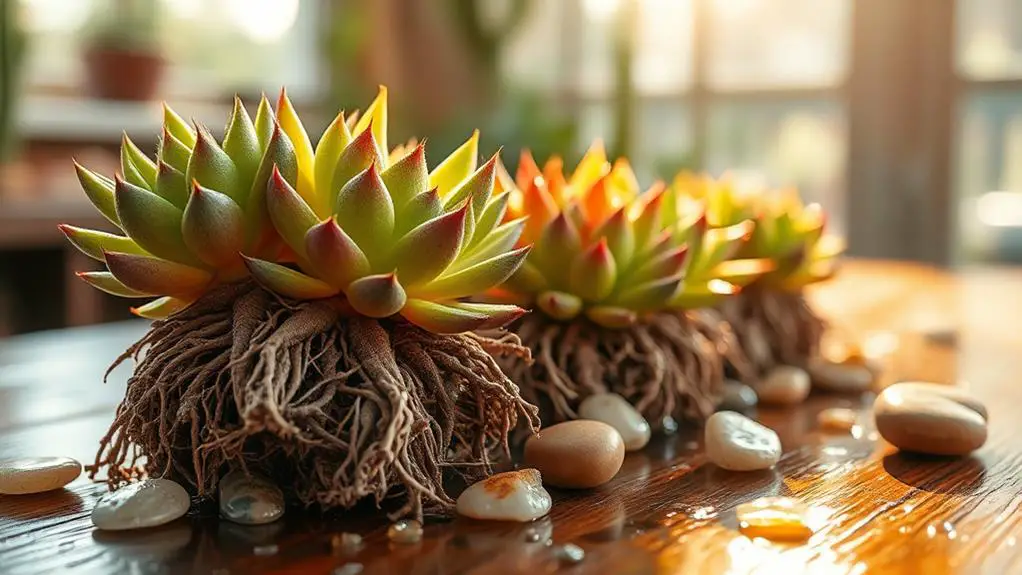
Maintaining proper nutrient management is essential for keeping your succulents vibrant and healthy, especially when they're not planted in soil. Succulents need adequate nutrients to support their growth, and without soil, you've got to be extra mindful.
Using a diluted water-soluble fertilizer at half the recommended strength can provide the energy your succulents need. This helps them thrive in non-soil environments like sphagnum moss or sand.
Regular feeding is key to preventing nutrient deficiencies. If your succulents don't get enough nutrients, they might wilt or become unhealthy. So, make sure to keep an eye on their nutrient levels.
Since succulents in temporary setups can use up nutrients faster than those in soil, monitoring nutrient levels is vital. The choice of potting medium affects how well nutrients are retained.
Sphagnum moss, for example, can hold onto nutrients, but it's important to check that your succulents are getting what they need. By managing nutrients carefully, you'll support the overall health of your plants, ensuring they stay strong and beautiful.
Hydration and Light
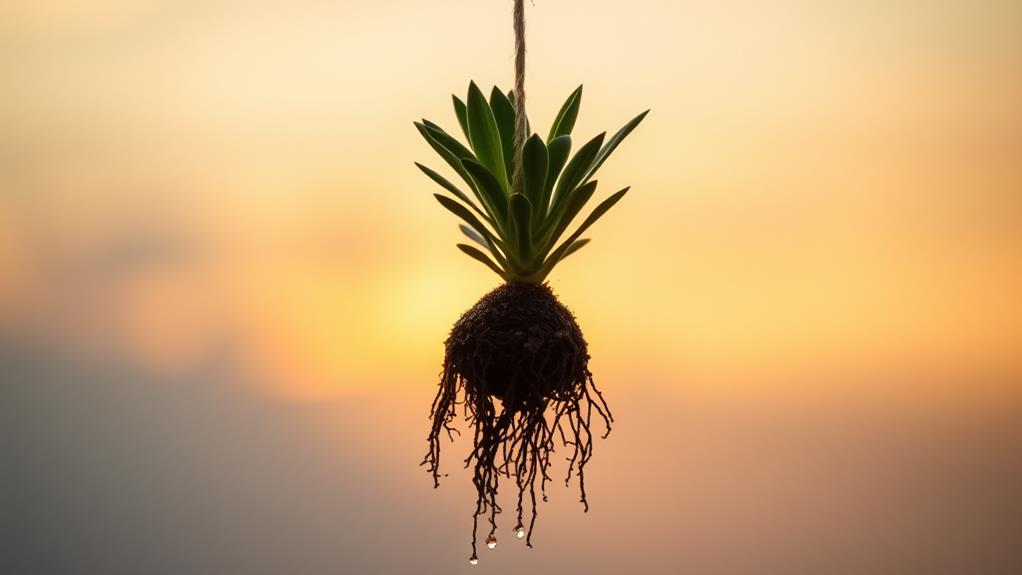
When growing succulents without soil, you must pay close attention to their hydration and light needs. Ensuring proper water and light is essential for their survival and health. Succulents need regular water to prevent root desiccation. Small, frequent waterings work best to avoid overwatering. You can mist them or use a syringe to provide adequate hydration, ensuring moisture without saturating the roots.
Bright, indirect sunlight is ideal for succulents. Too much direct sunlight can burn their roots, while too little light can make them stretch and weaken. Monitoring the amount of light they get is important. Place them in a spot where they receive enough indirect sunlight.
In hot climates, outdoor succulents might need water every 1-3 weeks. Indoor or cooler climates allow for longer intervals, between 1-3 months. Keep an eye on environmental conditions like light intensity and humidity, as these directly influence their hydration needs.
Here's a quick reference table for understanding their care:
| Climate | Watering Frequency | Light Requirement |
|---|---|---|
| Hot Outdoor | Every 1-3 weeks | Bright, indirect |
| Indoor/Cooler | Every 1-3 months | Bright, indirect |
| Soil-less | Frequent misting | Indirect sunlight |
Alternative Potting Mediums
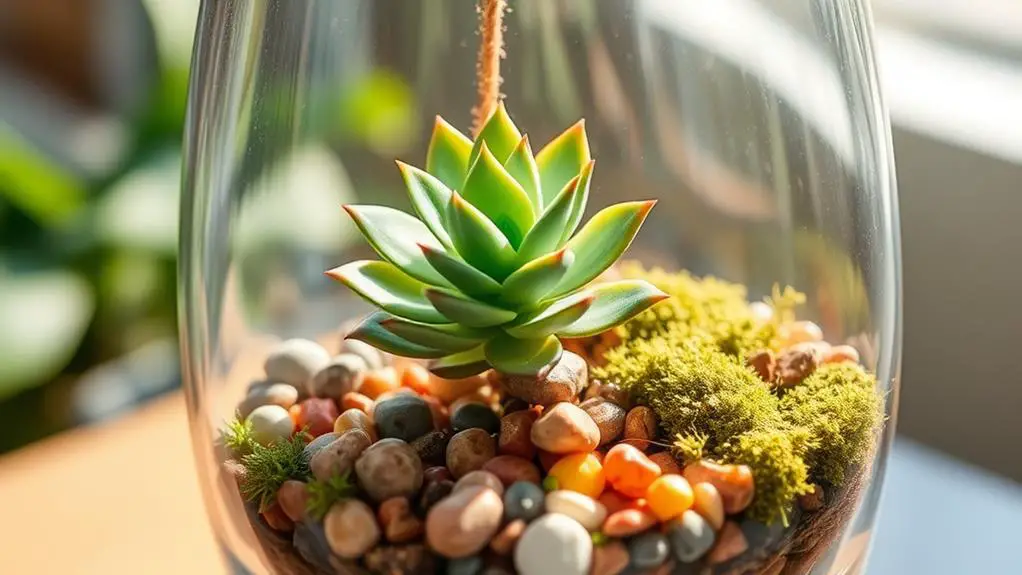
Exploring alternative potting mediums for succulents opens up a range of possibilities that can cater to their specific needs. You don't have to stick with traditional potting soil.
Sphagnum moss is a great option because it retains moisture while supporting the roots. This makes it an excellent choice for many succulent varieties.
Another popular medium is sand. It offers good drainage and grip for roots, making it ideal for succulents adapted to sandy environments.
Loose rocks can also be used. They provide aeration and prevent root rot by allowing excess water to drain away quickly. This keeps your succulents healthy and happy.
You can get creative by mixing different alternative potting mediums. Combining sand with perlite or pumice, for example, enhances both moisture retention and drainage. This mix creates prime conditions for succulent growth.
Frequently Asked Questions
How Long Can Succulents Last Without Soil?
You can keep succulents without soil for up to two weeks. Just mist them regularly and guarantee they get indirect light. After two weeks, they'll need soil to avoid wilting and nutrient deficiencies.
Can Succulents Survive 2 Weeks Without Water?
Yes, succulents can survive two weeks without water. They store water in their leaves, stems, and roots. However, you should watch for signs of dehydration like wrinkling leaves and provide water if they appear stressed.
How Long Can Plants Last Without Soil?
Plants can survive without soil for varying lengths of time, depending on their type. You'll need to provide proper care, like hydration and light. Regular monitoring is essential to guarantee they don't wilt and need replanting.
How Long Can I Leave My Succulents Outside?
You can leave your succulents outside for up to two weeks with proper care. Make sure to hydrate them regularly and provide partial shade during peak summer months to prevent overheating and moisture loss.
Conclusion
Don't worry, your succulents can do fine without soil for a short time, as long as you care for them properly. Keep an eye on their hydration, but don't overwater. Make sure they get enough light and consider alternative potting mediums if needed. With attention and care, your succulents will stay healthy and happy. Just remember, while they can survive temporarily without soil, they'll need it eventually to truly thrive. You've got this!

